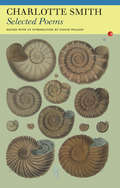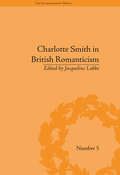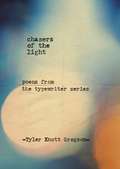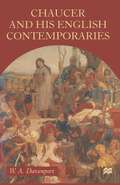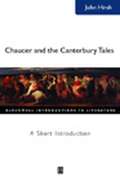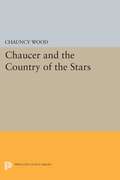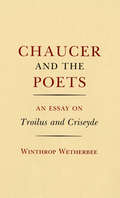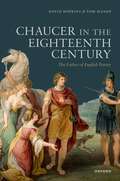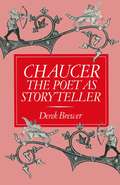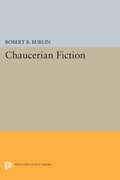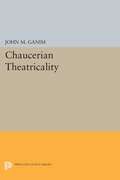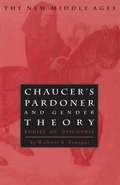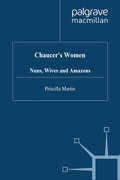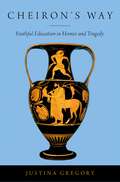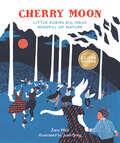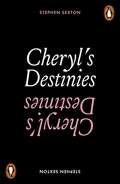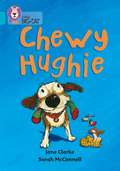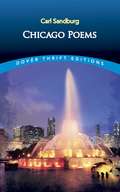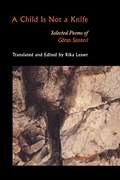- Table View
- List View
Charlotte Smith: Selected Poems (Fyfield Bks.)
by Charlotte SmithThis book presents an ideal introduction to the full range of the works of Charlotte Smith, whose Romantic sensibility is an expression of a specifically female experience, from her influential sonnets and poems for children to extracts from her French Revolution poem.
Charlotte Smith and the Sonnet: Form, Place and Tradition in the Late Eighteenth Century (Romantic Reconfigurations: Studies in Literature and Culture 1780-1850 #9)
by Bethan RobertsAn Open Access edition of this book is available on the Liverpool University Press website and the OAPEN library.This book offers the first full-length study of Charlotte Smith’s Elegiac Sonnets and clarifies its ‘place’ – in multiple ways – in literary history as a work celebrated for ‘making it new’, yet deeply engaged with the literary past. It argues that Smith’s sonnets are constituted by three intertwined concerns: with tradition, place and the sonnet form itself, whereby the subjects of Smith’s sonnets – across birds, rivers, the sea, plants and flowers – are bound up with the literary context in which she wrote. Charlotte Smith and the Sonnet shows that Smith’s verse engages more deeply with tradition than has hitherto been realised and revises our understanding not only of Smith’s career but also of the sonnet in eighteenth-century England. The book also illuminates Smith’s place in posterity, as a popular poet – influencing figures ranging from Wordsworth and Coleridge to Constable – who was subsequently obscured in literary history. It reveals the complex processes underpinning Smith’s reception and paradoxical position from the late eighteenth century to the present day, and shows that the appropriation of place itself was an important way in which aspects of literary tradition have been negotiated and understood by Smith, her predecessors, contemporaries and successors.
Charlotte Smith in British Romanticism (The Enlightenment World)
by Jacqueline LabbeCharlotte Smith's early sonnets established the genre as a Romantic form; her novels advanced sensibility beyond its reliance on emotional facility; and her blank verse initiated one of the most familiar of Romantic verse forms. This volume draws together the best of current scholarship.
Charlotte Smith in British Romanticism (The Enlightenment World #5)
by Jacqueline LabbeCharlotte Smith's early sonnets established the genre as a Romantic form; her novels advanced sensibility beyond its reliance on emotional facility; and her blank verse initiated one of the most familiar of Romantic verse forms. This volume draws together the best of current scholarship.
Chasers of the Light: Poems From The Typewriter Series
by Tyler Knott GregsonI would love to say that you make me weak at the knees, but to be quite upfront and completely truthful, you make my body forget it has knees at all.One day, while browsing an antique store in Helena, Montana, photographer Tyler Knott Gregson stumbled upon a vintage Remington typewriter for sale. Standing up and using a page from a broken book he was buying for $2, he typed a poem without thinking, without planning, and without the ability to revise anything.He fell in love.Three years and almost one thousand poems later, Tyler is now known as the creator of the Typewriter Series: a striking collection of poems typed onto found scraps of paper or created via blackout method.Chasers of the Light features some of his most insightful and beautifully worded pieces of work-poems that illuminate grand gestures and small glimpses, poems that celebrate the beauty of a life spent chasing the light.
Chaucer and his English Contemporaries: Prologue and Tale in The Canterbury Tales
by Tony DavenportModern ways of presenting Chaucer have often made his work seem 'normal' so that The Canterbury Tales and its much-studied General Prologue are seen as archetypes of narrative and prologue. Tony Davenport argues that study of Chaucer's major work alongside contemporary English poems reveals the odd and extreme aspects of Chaucer's writing as well as the daring and experimental qualities in his work. The focus of the book is on strategies of narrative and discourse, but also includes discussion of other much-studied Middle English poems.
Chaucer and the Canterbury Tales: A Short Introduction (PDF)
by John C. HirshThis concise and lively survey introduces students with no prior knowledge to Chaucer, and particularly to The Canterbury Tales. Provides essential facts about Chaucer, as well as a framework for thinking about his poetry. Encourages an engaged reading of The Canterbury Tales. Introduces students to the historical and religious background needed to understand the contexts in which Chaucer wrote. Provides essential facts about Chaucer, as well as a framework for thinking about his poetry. Encourages an engaged reading of The Canterbury Tales. Introduces students to the historical and religious background needed to understand the contexts in which Chaucer wrote.
Chaucer and the Country of the Stars: Poetic Uses of Astrological Imagery (PDF)
by Chauncy WoodProfessor Wood examines in detail the astrological references in The Canterbury Tales, Troilus and Criseyde, and The Complaint of Mars, using mediaeval source materials not only to elucidate the technicalities of the imagery but also to analyze its poetic function.Originally published in 1970.The Princeton Legacy Library uses the latest print-on-demand technology to again make available previously out-of-print books from the distinguished backlist of Princeton University Press. These editions preserve the original texts of these important books while presenting them in durable paperback and hardcover editions. The goal of the Princeton Legacy Library is to vastly increase access to the rich scholarly heritage found in the thousands of books published by Princeton University Press since its founding in 1905.
Chaucer and the Poets: An Essay on Troilus and Criseyde
by Winthrop WetherbeeIn this sensitive reading of Chaucer’s Troilus and Criseyde, Winthrop Wetherbee redefines the nature of Chaucer’s poetic vision. Using as a starting point Chaucer’s profound admiration for the achievement of Dante and the classical poets, Wetherbee sees the Troilus as much more than a courtly treatment of an event in ancient history—it is, he asserts, a major statement about the poetic tradition from which it emerges. Wetherbee demonstrates the evolution of the poet-narrator of the Troilus, who begins as a poet of romance, bound by the characters’ limited worldview, but who in the end becomes a poet capable of realizing the tragic and ultimately the spiritual implications of his story.
Chaucer in the Eighteenth Century: The Father of English Poetry
by David Hopkins Tom MasonThis volume is a study of how the poetry of Chaucer continued to give pleasure in the eighteenth century despite the immense linguistic, literary, and cultural shifts that had occurred in the intervening centuries. It explores translations and imitations of Chaucer's work by Dryden, Pope, and other poets (including Samuel Cobb, John Dart, Christopher Smart, Jane Brereton, William Wordsworth, and Leigh Hunt) from the early eighteenth to the early nineteenth centuries, as well as investigating the beginnings of modern Chaucer editing and biography. It pays particular attention to critical responses to Chaucer by Dryden and the brothers Warton, and includes a chapter on the oblique presence of Chaucer in Samuel Johnson's Dictionary. It explores the ways in which Chaucer's poetry (including several works now known not to be by him) was described, refashioned, reimagined, and understood several centuries after its initial appearance. It also documents the way that views of Chaucer's own character were inferred from his work. The book combines detailed discussion of particular critical and poetic texts, many of them unfamiliar to modern readers, with larger suggestions about the ways in which poetry of the past is received in the future.
Chaucer in the Eighteenth Century: The Father of English Poetry
by David Hopkins Tom MasonThis volume is a study of how the poetry of Chaucer continued to give pleasure in the eighteenth century despite the immense linguistic, literary, and cultural shifts that had occurred in the intervening centuries. It explores translations and imitations of Chaucer's work by Dryden, Pope, and other poets (including Samuel Cobb, John Dart, Christopher Smart, Jane Brereton, William Wordsworth, and Leigh Hunt) from the early eighteenth to the early nineteenth centuries, as well as investigating the beginnings of modern Chaucer editing and biography. It pays particular attention to critical responses to Chaucer by Dryden and the brothers Warton, and includes a chapter on the oblique presence of Chaucer in Samuel Johnson's Dictionary. It explores the ways in which Chaucer's poetry (including several works now known not to be by him) was described, refashioned, reimagined, and understood several centuries after its initial appearance. It also documents the way that views of Chaucer's own character were inferred from his work. The book combines detailed discussion of particular critical and poetic texts, many of them unfamiliar to modern readers, with larger suggestions about the ways in which poetry of the past is received in the future.
Chaucerian Fiction (PDF)
by Robert B. BurlinBy analyzing Chaucer's major poetic works, Robert Burlin succeeds in isolating thematic undercurrents with a bearing on the poet's process of composition. He is thus able to relate individual poems to Chaucer's view of himself as a writer, and to assess the internal evidence for a Chaucerian theory of fiction. Professor Burlin contends that a logic underlies Chaucer's aesthetic assumptions whose imaginative configuration appears both simple and inevitable in the context of his poetic development. The author first explores possible antecedents for the terms "experience" and auctoritee, and shows that this common antinomy provides the basis for dividing the poems into three groups.In the "poetic fictions," Chaucer speculates on the value of poetic activity, on the sources of its affect, and on its validity as a means of apprehension. The "philosophic fictions" concentrate on the epistemological aspect of literary activity. In a final group of poems, termed "psychological fictions," the poet explores the speaker's unspoken motives, as well as his pronounced intentions, in telling a tale.Originally published in 1977.The Princeton Legacy Library uses the latest print-on-demand technology to again make available previously out-of-print books from the distinguished backlist of Princeton University Press. These editions preserve the original texts of these important books while presenting them in durable paperback and hardcover editions. The goal of the Princeton Legacy Library is to vastly increase access to the rich scholarly heritage found in the thousands of books published by Princeton University Press since its founding in 1905.
Chaucerian Theatricality (PDF)
by John M. GanimWhereas modern criticism has emphasized the unity and sense of permanence in The Canterbury Tales, John Ganim alerts us to a dialectically opposing dimension that Chaucer's poetics shares with the popular culture of the late Middle Ages: his celebration of the ephemeral and his sense of performance. Ganim uses the concept of theatricality to illuminate Chaucer's manipulations of the forms of popular culture and high literary discourse. He calls upon recent work in semiotics and social history to question Mikhail Bakhtin's notion of the "carnivalesque" and the "dialogic," at the same time suggesting Bakhtin's usefulness in understanding Chaucer.This book includes chapters on how Chaucer adopts the voice of such popular literary forms as chronicles and pious collections, on his equivalence between his own image making and dramatic performance, and on Chaucer's and Boccaccio's handling of the related issues of popular understanding and the creation of illusions. The book concludes by describing how Chaucer conflates "noise" and popular expression, simultaneously appropriating and distancing himself from his richest cultural context.Originally published in 1990.The Princeton Legacy Library uses the latest print-on-demand technology to again make available previously out-of-print books from the distinguished backlist of Princeton University Press. These editions preserve the original texts of these important books while presenting them in durable paperback and hardcover editions. The goal of the Princeton Legacy Library is to vastly increase access to the rich scholarly heritage found in the thousands of books published by Princeton University Press since its founding in 1905.
Chaucer's Pardoner and Gender Theory: Bodies of Discourse (The New Middle Ages)
by NA NAChaucer s Pardoner and Gender Theory, the first book-length treatment of the character, examines the Pardoner in Chaucer s Canterbury Tales from the perspective of both medieval and twentieth-century theories of sex, gender, and erotic practice. Sturges argues for a discontinuous, fragmentary reading of this character and his tale that is genuinely both premodern and postmodern. Drawing on theorists ranging from St. Augustine and Alain de Lille to Judith Butler and Eve Kosofsky Sedgwick, Sturges approaches the Pardoner as a representative of the construction of historical - and sexual - identities in a variety of historically specific discourses, and argues that medieval understandings of gender remain sedimented in postmodern discourse.
Chaucer's Women: Nuns, Wives And Amazons
by P. MartinIn this challenging study Priscilla Martin investigates the subjects of women, sex and gender in Chaucer's poetry. She argues convincingly that these are Chaucer's major subjects and that he presents them as an area of human experience fraught with problems. Women, instead of producing texts and meanings themselves, are trapped in the books and meanings of others, and so the Madonna and the courtly heroine, the nun and the wife, are familiar but questionable images of constructed femininity. '...an intelligent, sensitive, fresh and close reading which focuses upon Chaucer's women ... unconventional and subtle' - John J.McGavin, Times Higher Education Supplement
Cheiron's Way: Youthful Education in Homer and Tragedy
by Justina GregoryThis book studies the social and ethical formation of youthful figures in Homer, Sophocles, and Euripides. Every fictional character comes with a past attached, a presumed personal history that is both implicit and explicit; for the youthful heroes and heroines of epic and tragedy, early education figures significantly in that past. Cheiron's Way takes as its point of departure the words of Homer's Phoenix to Achilles, who claims, "I made you the man you are" as he pleads with his former pupil to let go of his anger. The book begins by exploring topics relevant to heroic and tragic education: age classes, rites of passage, verbal modes of instruction, social conditioning, mentoring, peer role models, and the controversial balance between nature and nurture. It introduces the first teacher in the Greek tradition, Cheiron the centaur, who founded a school for young heroes in his Thessalian cave and instructed Achilles, Jason, and others with mixed success. Next it turns to the Iliadic Achilles, who achieves maturity by way of successive crises-a crisis of disillusionment with the assumptions that shaped his heroic education, followed by a crisis of empathy for his adversary-and who becomes an influential prototype for tragedy. Examination of the Odyssey suggests that while Odysseus received a normative heroic upbringing and Nausicaa internalizes social expectations for young women, Telemachus is more of an outlier. In tragic representations of education Sophocles' Ajax and Neoptolemus replicate the Achillean pattern only partially and unsuccessfully, as does Euripides' Hippolytus; only Achilles and Iphigenia in Euripides' Iphigenia in Aulis achieve an emotional maturity commensurate with the Iliadic Achilles'. Yet all these texts confirm, as elegantly argued in this book, the perennial lure, despite uncertain results, of the educational enterprise for communities, students, and teachers.
Cheiron's Way: Youthful Education in Homer and Tragedy
by Justina GregoryThis book studies the social and ethical formation of youthful figures in Homer, Sophocles, and Euripides. Every fictional character comes with a past attached, a presumed personal history that is both implicit and explicit; for the youthful heroes and heroines of epic and tragedy, early education figures significantly in that past. Cheiron's Way takes as its point of departure the words of Homer's Phoenix to Achilles, who claims, "I made you the man you are" as he pleads with his former pupil to let go of his anger. The book begins by exploring topics relevant to heroic and tragic education: age classes, rites of passage, verbal modes of instruction, social conditioning, mentoring, peer role models, and the controversial balance between nature and nurture. It introduces the first teacher in the Greek tradition, Cheiron the centaur, who founded a school for young heroes in his Thessalian cave and instructed Achilles, Jason, and others with mixed success. Next it turns to the Iliadic Achilles, who achieves maturity by way of successive crises-a crisis of disillusionment with the assumptions that shaped his heroic education, followed by a crisis of empathy for his adversary-and who becomes an influential prototype for tragedy. Examination of the Odyssey suggests that while Odysseus received a normative heroic upbringing and Nausicaa internalizes social expectations for young women, Telemachus is more of an outlier. In tragic representations of education Sophocles' Ajax and Neoptolemus replicate the Achillean pattern only partially and unsuccessfully, as does Euripides' Hippolytus; only Achilles and Iphigenia in Euripides' Iphigenia in Aulis achieve an emotional maturity commensurate with the Iliadic Achilles'. Yet all these texts confirm, as elegantly argued in this book, the perennial lure, despite uncertain results, of the educational enterprise for communities, students, and teachers.
Cherry Moon: Little Poems Big Ideas Mindful of Nature
by Zaro WeilWinner of the CLPE Award for Children's Poetry 2020. This dazzling poetry collection bubbles with excitement and creativity, capturing the sheer joy of the natural world. Discover parades of beast-doodles, preposterous penguins, talking blossoms, playful birds, humble fleas and a host of other exotic and everyday creatures who jump off the page and into our hearts.Thought-provoking, delightfully original and beautifully illustrated, Cherry Moon will encourage children of every age to explore the power, enchantment and wonderfulness of poetry and nature.
Cheryl's Destinies
by Stephen SextonShortlisted for the Forward Prize for Best Collectionhistory is what we call / what might have happened differently / and didn'tIt is the decade of centuries, and Cheryl tells us our fortune. Radicals liberate a zoo, teenagers flirt in a bowling alley, and the dead are cherished. In these inventive, playful, dream-like poems, Stephen Sexton takes us on a journey through the past and the present, while Cheryl translates from the future, showing us how we exist in all three at once.Reckoning with both public and private tragedies, the book is divided into three parts. In Part One, the poems range across old Europe: 'Edelweiss' and Titanic setting sail, to a transatlantic, cross-century symposium in Part Two, where two giants perfect their arts in collaboration. In Part Three we are back in the land where the past keeps breaking through, it's practically always the anniversary of something terrible, but there's always Cheryl in the moonlight and her deck of tarot cards. A thrillingly strange exploration of the comfort of the fantastical when the real is hard to bear, Cheryl's Destinies is the enchanting follow-up to the Forward Prize for Best First Collection-winning If All the World and Love Were Young, by one of the most exciting young poets writing today.
Chewy Hughie: Band 07/Turquoise (Collins Big Cat)
by Jane Clarke Sarah McConnell Cliff Moon Collins Big CatChewy Hughie chews anything and everything he can get his paws on, driving his owners to distraction! But what happens when Chewy Hughie discovers a packet of bubblegum… This is a lively rhyming story by Jane Clarke, illustrated with stunning artwork from Sarah McConnell. Pages 14-15 provide a storymap of the house, which consolidates understanding, and provides a wealth of speaking and listening opportunities. Turquoise/Band 7 books offer literary language and extended descriptions, with longer sentences and a wide range of unfamiliar terms. This book has been levelled for Reading Recovery.
Chicago Poems: Unabridged (Dover Thrift Editions)
by Carl SandburgChicago Poems (1916) was Carl Sandburg's first-published book of verse. Written in the poet's unique, personal idiom, these poems embody a soulfulness, lyric grace, and a love of and compassion for the common man that earned Sandburg a reputation as a "poet of the people."Among the dozens of poems in this collection are such well-known verses as "Chicago," "Fog," "To a Contemporary Bunkshooter," "Who Am I?" and "Under the Harvest Moon," as well as numerous others on themes of war, immigrant life, death, love, loneliness, and the beauty of nature. These early poems reveal the simplicity of style, honesty, and vision that characterized all of Sandburg's work and earned him enormous popularity in the 1920s and '30s and a Pulitzer prize in poetry in 1951.
A Child Is Not a Knife: Selected Poems of Göran Sonnevi (The Lockert Library of Poetry in Translation #41)
by Göran SonneviGöran Sonnevi is one of Sweden's most celebrated, respected, and prolific poets. For this first book-length selection of Sonnevi to appear in English, Rika Lesser has chosen works written between 1971 and 1989--although most of the poems come from the last decade and from Sonnevi's last three books, which form part of the single oändlig [unending/infinite/interminable] poem that he continues to write from book to book. Of Lesser's introduction to the work, Richard Howard writes, "Lesser's wonderful prose texts at the outset provide not only an ingress into complex and baffling matter but one of the most determined statements of the translator's text since Walter Benjamin."From "Åby, Öland; 1982"We are here in the ultimate lives of our bodiesnegations of the ultimate negationWe are complete parts of the worldWe rise up out of infinitylike the limestone flats from the sea Like the starsWe are denials of infinityOne day we shall reach all the way there
A Child Is Not a Knife: Selected Poems of Goran Sonnevi (PDF)
by Göran Sonnevi Rika LesserGöran Sonnevi is one of Sweden's most celebrated, respected, and prolific poets. For this first book-length selection of Sonnevi to appear in English, Rika Lesser has chosen works written between 1971 and 1989--although most of the poems come from the last decade and from Sonnevi's last three books, which form part of the single oändlig [unending/infinite/interminable] poem that he continues to write from book to book. Of Lesser's introduction to the work, Richard Howard writes, "Lesser's wonderful prose texts at the outset provide not only an ingress into complex and baffling matter but one of the most determined statements of the translator's text since Walter Benjamin." From "Åby, Öland; 1982" We are here in the ultimate lives of our bodiesnegations of the ultimate negationWe are complete parts of the worldWe rise up out of infinity like the limestone flats from the sea Like the starsWe are denials of infinityOne day we shall reach all the way there
